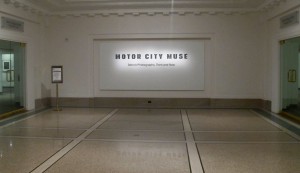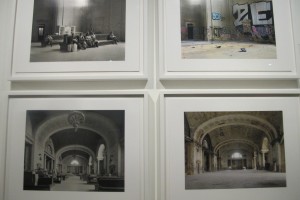
“Motor City Muse: Detroit Photographs, Then And Now” at the DIA
“Motor City Muse: Detroit Photographs, Then and Now.”
While much of the world is preoccupied with the future, Detroit seems to look back as often as it looks forward. Former city denizens often speak of Detroit in a tone of bewilderment and barest understanding, trying to grasp at exactly what happened to bring such a thriving epicenter down from its glory days. Newer residents have their eyes set on Detroit’s potential, seeing nothing but possibilities and impatiently waiting for entrenched city politics and old ways to clear the way for the rising phoenix of Detroit’s future. Inarguably, Detroit is a city in the process of finding a new identity, and this conversation between Detroit’s past and present is highlighted beautifully in the Detroit Art Institute’s (DIA) current photography exhibit, which opened Friday, December 14, 2012 and will run through Sunday, June 16.

A grid of images from Karin Jobst, who aptly captures the sense impression of present-day Detroit.
The exhibit features a wide array of views on the city, with more than 100 photographs by photographers Henri Cartier-Bresson, Robert Frank, Dave Jordano, Karin Jobst, Detroiters Nicola Kuperus, Russ Marshall and Bill Rauhauser, along with selections from the Detroit School of Automotive Photography. Robert Frank’s 1950s-era images of Detroit street scenes and automotive line workers capture a bygone time in the appropriate black and white medium. While no Detroit retrospective can hope to be free of the spectre of the automotive industry, the show’s selections from the Detroit School of Automotive Photography are as charming and engaging as one might expect from classic advertising imagery meeting the industry gold standard for “car shooters.” More adversarial are the images of Nicola Kupernus, who explores the relationship between cars and the women used to sell them with the repeated juxtaposition of a prone female body, lying apparently dead adjacent to all types of classic automobiles, as in “Car,” “Impala,” “T-Bird,” and “Flat.”

Dave Jordano’s wall of paired images, obsessively recreating shots he originally made decades ago.
Best capturing the spirit of “Then and Now,” however, is the work of Dave Jordano, who has photographed Detroit over the course of decades. The main wall of the exhibit is dominated by diptychs, featuring images shot in the 1970’s paired side-by-side with the exact same setting in present times. The contrast is stark, fascinating, and sometimes but not always evocative of “good old days” sentimentality. True, the old train station looks more alive than dead in its 1970’s iteration, but just as often what was once a parking lot has become a field of wild flowers. Whether that repreesnts progress or perdition all depends, of course, on your perspective.
The Detroit Institute of Arts, 5200 Woodward Ave., Detroit; 313-833-7900; www.dia.org.
Recent Content
-
Artsarticle ·
-
Artsarticle ·
-
Artsarticle ·
